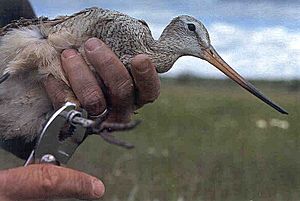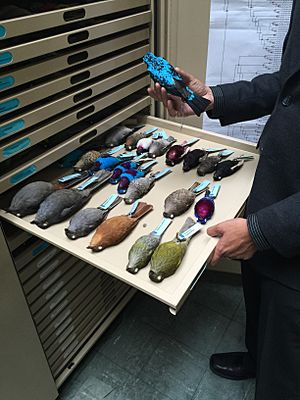Ornithology facts for kids
Ornithology is the scientific study of birds. If you love birds and study them, you might be called an ornithologist. These scientists learn all about birds, from how they fly and sing to where they live and what they eat.
Studying birds has helped us understand many important ideas in science. For example, ornithologists have taught us a lot about how different species of animals develop. They also helped us learn about instincts, how animals learn, and how different animals fit into their environments. Bird studies are also very important for protecting birds and their habitats.
Today, many scientists study birds, but they might call themselves biologists or ecologists instead of just "ornithologists." This is because the ideas learned from studying birds often apply to many other animals too! Ornithologists use many different tools and methods. They work both in labs and out in nature to learn more about our feathered friends.
| Branches of Zoology |
|---|
| Acarology — Arachnology — Cetology — Comparative anatomy — Entomology — Ethology — Herpetology — Ichthyology — Mammalogy — Ornithology — Paleozoology — Paleontology |
Contents
Why Study Birds?
Studying birds is super important for many reasons. Birds are found almost everywhere on Earth. This makes them great for understanding how animals adapt to different places. By watching birds, scientists have learned about how new species form over time. They also learn about how animals behave, like why birds sing or how they find food.
Birds also show us how different animals live together in an ecosystem. They help us understand how animals use their environment. For example, some birds eat insects, helping to control pest populations. Others spread seeds, helping plants grow in new areas.
Birds and Conservation
One of the most important parts of ornithology is protecting birds. Many bird species are facing threats like habitat loss or climate change. Ornithologists study these problems to find ways to help birds survive. They might track bird populations or work to protect important bird habitats. Their work helps make sure that future generations can also enjoy birds.
How Ornithologists Study Birds
Ornithologists use many cool tools and techniques to study birds. They don't just watch birds with binoculars! They use special equipment to gather information.
Fieldwork and Observation
A lot of ornithology happens outdoors. Scientists go into forests, wetlands, and even deserts to watch birds. They use binoculars and telescopes to observe birds from a distance. They might also use cameras to take pictures or videos of birds. This helps them study bird behavior without disturbing the animals.
Bird Banding
One common way to study birds is through banding. This involves carefully catching a bird, placing a small, lightweight band on its leg, and then releasing it. Each band has a unique number. If the bird is caught again later, scientists can learn where it traveled and how long it lived. This helps them understand bird migration patterns and how bird populations change.
Using Technology
Modern ornithologists use a lot of technology. They might use GPS trackers to follow birds on long journeys. Drones can help them survey large areas or reach nests in high places. Scientists also use sound recorders to study bird calls and songs. These tools help them collect lots of data quickly and safely.
Museum Collections
Museums play a big role in ornithology. They keep collections of bird specimens, like preserved bird skins or skeletons. These collections are like libraries for scientists. Researchers can study these specimens to learn about bird anatomy, how species have changed over time, or what birds looked like in the past.
Images for kids
-
Geese from a wall panel from the tomb of Nefermaat, Egypt c. 2575–2551 B.C.
-
Cover of Ulisse Aldrovandi's Ornithology, 1599
-
An Experiment on a Bird in the Air Pump, Joseph Wright of Derby, 1768
-
A mounted specimen of a red-footed falcon
-
Page from an early field guide by Florence Augusta Merriam Bailey
-
Summer distribution and abundance of Canada goose using data from the North American Breeding Bird Surveys 1994–2003
-
Red-billed queleas are a major agricultural pest in parts of Africa.
See also
 In Spanish: Ornitología para niños
In Spanish: Ornitología para niños















